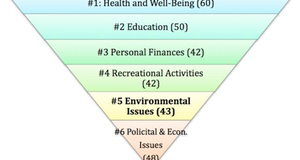From Earth Common Journal VOL. 3 NO. 1Soaring to Green Heights: The Current Sustainable Initiatives in the Commercial Airline IndustryResultsEnvironmentalism is at the forefront of the industry. The environmental reports of both Boeing and Airbus make persuasive arguments in relation to the development of greener technologies. The focus of these reports can be seen in practice in the specifications of the Boeing 787 Dreamliner and the Airbus A380. Both Boeing and Airbus are making strides to promote a more sustainable industry and develop greener technologies. The wordles characterize the changes that are being made in the manufacturers’ environmental publications, while the Boeing 787 Dreamliner and the Airbus A380 are proving that sustainable flight is possible. As described by Christ (2012), the Airbus A380 “has the potential to burn up to 20 percent less fuel than most aircraft” while the Boeing 787 Dreamliner is “billed as the world’s first ‘eco-friendly’ airplane for its lighter composite construction, fuel-efficient engines, and improved aerodynamics” (para. 4). In regards to the respective environmental reports, Boeing states, “the most significant environmental improvements occur when they are designed into a product from the beginning. This forward-thinking approach, which we call the Design for Environment, includes analyzing a products environmental footprint over its operational life cycle” (2012, p. 5). In the same vein, Airbus describes that “[today], more than ever, innovation provides the key to meeting the environmental responsibilities of the aviation sector and Airbus has not hesitated to take on the challenge” (2013a, p. 8). Both manufacturers possess a zest for further development and strive to be the leaders in aviation evolution and the creation of a sustainable industry. Now, at this point it should be mentioned that green technology has a large learning curve, especially in relation to the Boeing 787 Dreamliner. Boeing has been facing many challenges in relation to this aircraft and, because of it, has had to reassess specifications. Most recently, the 787 Dreamliner faced issues associated with some aircrafts’ batteries, resulting in all of the aircrafts being recalled (Associated Press, 2013, para. 1). With that being said, Boeing has been working toward rectifying this issue. In regards to the PRME principles four and five (UN PRME, 2013), it is fact that there is substantial research that is going in to developing these greener technologies. The manufacturers and the airlines can work together in dialogue to ensure that the needs of the environment are being met and carried out appropriately. The results here can give one insight into the strides that the commercial airline industry is making in order to prolong the longevity of air travel and lessening the impact it has on the environment. Conclusion and RecommendationsThe commercial airline industry has seen drastic changes as of late. The further greening of the industry is not something that is being taken lightly. There is a certain corporate social responsibility that the industry must confirm and, furthermore, develop ways in which to become more sustainable and decrease their environmental footprint. Because air travel is not something that can be disregarded, it is important, now more than ever, for these manufacturers to develop more sustainable technologies. As the demand for air travel is ever increasing, more planes will be taking to the sky, which means greener, less impactful technology is needed. Further research can be conducted in respect to the airplanes that specific airlines purchase. Additionally, a more focused look at the pollution levels that are caused by the commercial airline industry would be beneficial to further understanding the threat that planes pose to the environment. Contrasting and comparing the industry’s stance and government bodies’ opinions would also be an interesting facet for further research. While it would be ludicrous to suggest living in the twenty-first century without air travel, one must acknowledge the technological advancements that are being made in order to create a greener industry. The aircraft manufacturers will continue developing convenient and sustainable modes of transportation for years to come. ReferencesAirbus. (2013a). Sustainable aviation: Aviation environmental roadmap. Retrieved from http://www.airbus.com/company/environment/documentation/ Airbus. (2013b). Airbus family figures. Retrieved from http://www.airbus.com/fileadmin/media_gallery/files/brochures_publications/air craft_families/Airbus-Family-Figures-Apr13.pdf Associated Press. (2013, March 28). Boeing 787 ‘very close’ to flying, CEO says. Canadian Broadcasting Corporation. Retrieved from http://www.cbc.ca/news/business/story/2013/03/28/dreamliner-mcnerney.html Boeing Company. (2011). Airport compatibility brochure — 787. Retrieved from http://www.boeing.com/commercial/airports/acaps/787brochure.pdf Boeing Company. (2012). Environment report. Retrieved from http://www.boeing.com/aboutus/environment/environment_report_12/2012_env ironment_report.pdf Boeing Company. (2013a). 787 Dreamliner. Retrieved from http://www.boeing.com/boeing/commercial/787family/index.page? Boeing Company. (2013b). In plane view: A pictorial tour of the Boeing Everett Factory. Everett, WA: Boeing. Chen, F. (2012). Managers’ views on environmental management: An examination of the Taiwanese airline industry. Journal of Sustainable Development, 6(1), 65-75. DOI:10.5539/jsd.v6n1p65 Christ, C. (2012). Green class. National Geographic Traveller. Retrieved from http://travel.nationalgeographic.com/travel/traveler-magazine/tales-from-the- frontier/flying-green/ Cowper-Smith, A. & de Grosbois, D. (2011). The adoption of corporate social responsibility practices in the airline industry. Journal of Sustainable Tourism, 19(1), 59-77. DOI: 10.1080/09669582.2010.498918 Gaffney, D. (2008). Fly the eco-friendly skies. Popular Science. 272(2). 40-46. Retrieved from http://ehis.ebscohost.com/ehost/pdfviewer/pdfviewer?sid=b0a6c0ef-6b8f-46cc-9ebe-5c9029d63ce5%40sessionmgr112&vid=3&hid=101 Greener Planes — but lots more of them: Aviation industry flies in face of environment concerns. (2008). Strategic Direction, 24(6), 16-18. Retrieved from http://first.emeraldinsight.com/journal.htm?PHPSESSID=5436vkg4d0q8k8jg2g4q9pm1d2&issn=0258-0543&volume=24&issue=6&ft=1&article=0560240605 IATA. (2013a). About us. Retrieved from http://www.iata.org/about/Pages/index.aspx IATA. (2013b). IATA and the environment. Retrieved from http://www.iata.org/whatwedo/environment/Pages/index.aspx IATA. (2013c). Environmental policy. Retrieved from http://www.iata.org/policy/environment/Pages/default.aspx UN PRME. (2013). The principles of responsible management education. Retrieved from http://www.unprme.org/the-6-principles/index.php Suggested Reading from Inquiries Journal
Inquiries Journal provides undergraduate and graduate students around the world a platform for the wide dissemination of academic work over a range of core disciplines. Representing the work of students from hundreds of institutions around the globe, Inquiries Journal's large database of academic articles is completely free. Learn more | Blog | Submit Latest in Environmental Studies |

















